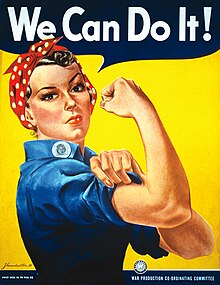From Wiki.
The term "Rosie the Riveter" was first used in 1942 in a song of the same name written by Redd Evans and John Jacob Loeb. The song was recorded by numerous artists, including the popular big band leader Kay Kyser, and became a national hit.[4] The song portrays "Rosie" as a tireless assembly line worker, doing her part to help the American war effort:[5]
All the day long,
Whether rain or shine
She’s part of the assembly line.
She’s making history,
Working for victory
Rosie the Riveter
Although real-life Rosie the Riveters took on male dominated trades during WWII, women were expected to return to their everyday housework once men returned from the war. Government campaigns targeting women were addressed solely at housewives, perhaps because already employed women would move to the higher-paid "essential" jobs on their own.[6] Most women opted to do this. Later many women chose to return to traditional work such as clerical or administration positions. However, some of these women continued working in the factories.
The individual who was the inspiration for the song was Rosalind P. Walter, who "came from old money and worked on the night shift building the F4U Corsair fighter." Later in life Walter was a philanthropist, a board member of the WNET public television station in New York and an early and long-time supporter of the Charlie Rose interview show.[4][7]
Rosie the Riveter became most closely associated with another real woman, Rose Will Monroe, who was born in Pulaski County, Kentucky[8][9][10] in 1920 and moved to Michiganduring World War II. She worked as a riveter at the Willow Run Aircraft Factory in Ypsilanti, Michigan, building B-29 and B-24 bombers for the U.S. Army Air Forces. Monroe achieved her dream of piloting a plane when she was in her 50's and her love of flying resulted in an accident that contributed to her death 19 years later.[4] Monroe was asked to star in a promotional film about the war effort at home. The song "Rosie the Riveter" was popular at the time,[2] and Monroe happened to best fit the description of the worker depicted in the song.[11] Rosie went on to become perhaps the most widely recognized icon of that era. The films and posters she appeared in were used to encourage women to go to work in support of the war effort.
According to the Encyclopedia of American Economic History, "Rosie the Riveter" inspired a social movement that increased the number of working American women to 20 million by 1944, a 57% increase from 1940.[citation needed] Although the image of "Rosie the Riveter" reflected the industrial work of welders and riveters during World War II, the majority of working women filled non-factory positions in every sector of the economy. What unified the experiences of these women was that they proved to themselves (and the country) that they could do a "man's job" and could do it well.[12] In 1942, just between the months of January and July, the estimates of the proportion of jobs that would be "acceptable" for women was raised by employers from 29 to 85%.[citation needed] African American women were some of those most affected by the need for women workers. It has been said that it was the process of whites working along blacks during the time that encouraged a breaking down of social barriers and a healthy recognition of diversity [12] African-Americans were able to lay the groundwork for the postwar civil rights revolution by equating segregation with Nazi white supremacist ideology.[12]
Conditions were sometimes harsh and pay was not always equal—the average man working in a wartime plant was paid $54.65 per week, while women were paid about $50.[13] Nonetheless, women quickly responded to Rosie the Riveter, who convinced them that they had a patriotic duty to enter the workforce. Some claim that she forever opened the work force for women, but others dispute that point, noting that many women were discharged after the war and their jobs were given to returning servicemen.[citation needed] These critics claim that when peace returned, few women returned to their wartime positions and instead resumed domestic vocations or transferred into sex-typed occupations such as clerical and service work.[14] For some, World War II represented a major turning point for women as they eagerly supported the war effort, while other historians emphasize that the changes were temporary and that immediately after the war was over, women were expected to return to traditional roles of wives and mothers, and finally, a third group has emphasized how the long-range significance of the changes brought about by the war provided the foundation for the contemporary woman’s movement.[15] Leila J. Rupp in her study of World War II wrote "For the first time, the working woman dominated the public image. Women were riveting housewives in slacks, not mother, domestic beings, or civilizers."[16]
After the war, the "Rosies" and the generations that followed them knew that working in the factories was in fact a possibility for women, even though they did not reenter the job market in such large proportions again until the 1970s. By that time factory employment was in decline all over the country.[citation needed]
On October 14, 2000, the Rosie the Riveter/World War II Home Front National Historical Park was opened in Richmond, California, site of fourKaiser shipyards, where thousands of "Rosies" from around the country worked (although ships at the Kaiser yards were not riveted, but rather welded).[17] Over 200 former Rosies attended the ceremony.[18][19][2]
The documentary film The Life and Times of Rosie the Riveter addresses the history of Rosie.
The image most iconically associated with Rosie is J. Howard Miller's famous poster forWestinghouse, titled We Can Do It!, which was modeled on the middle Michigan factory workerGeraldine Doyle in 1942, but this image was not actually intended to be Rosie the Riveter.[20]Rosie the Riveter is a fictional character.








